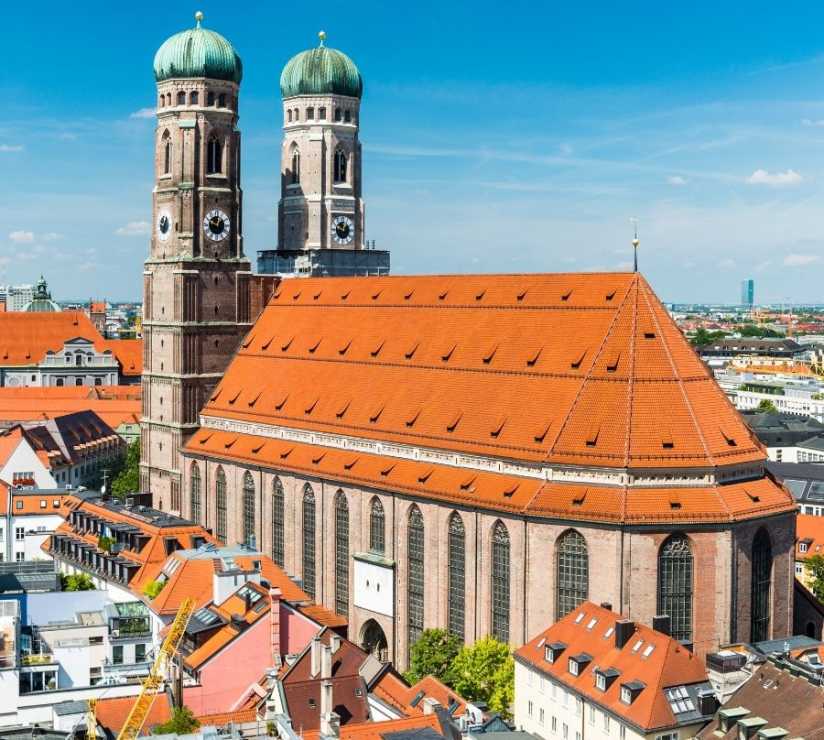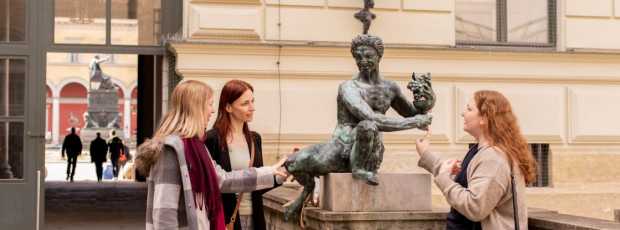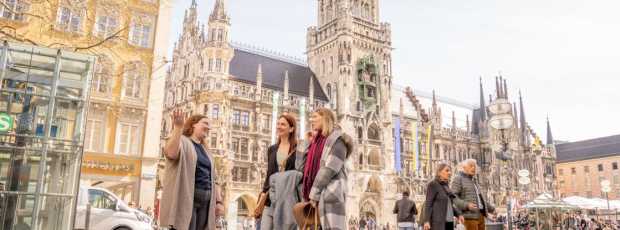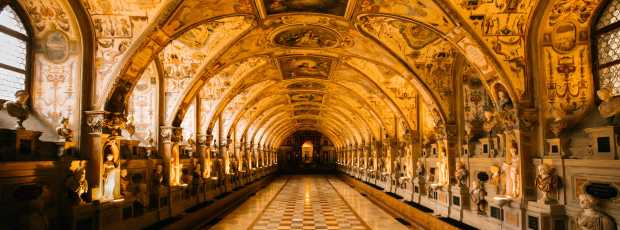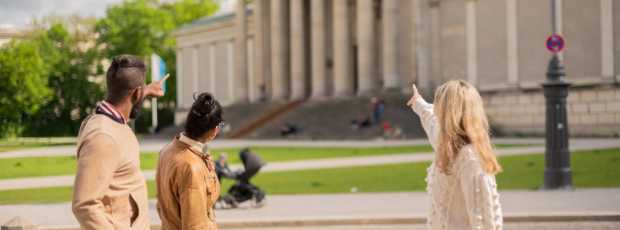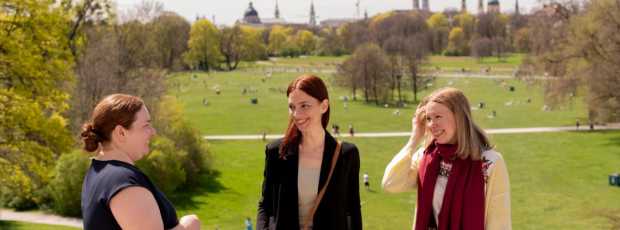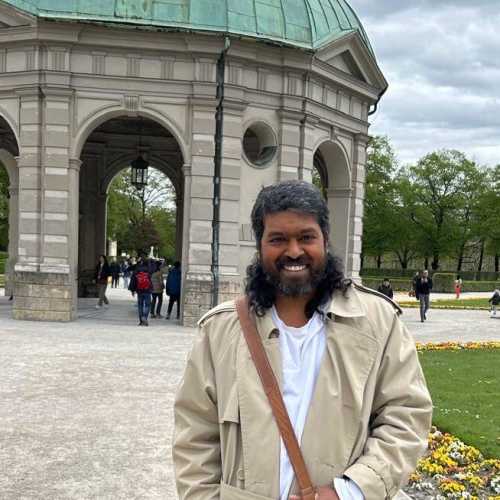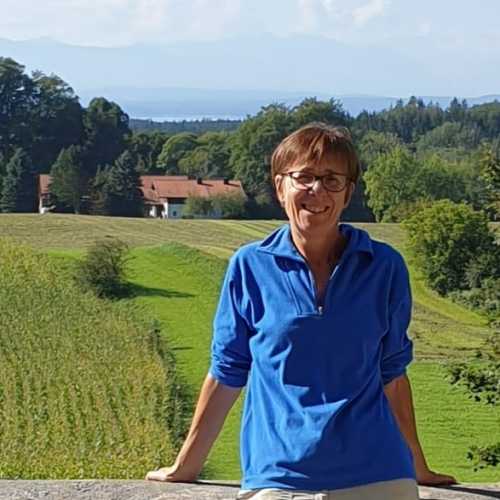Table Of Contents
- Why I'm Writing This Guide
- The March Munich Misconception
- Is Munich Worth Visiting in March?
- Understanding Munich's March Weather Patterns
- A Local's Strong Beer Festival Circuit
- Where Locals Still Sit Outside: March Beer Garden Culture
- Discovering Spring at Munich's Major Attractions
- What to Eat: March Food and Drinks
- Day Trips Worth the Chill
- Navigating Munich's Cultural Scene in March
- Hidden Gems and Off-the-Beaten-Path March Adventures
- Practical Tips for Visiting Munich in March
- Making the Most of March Evenings in Munich
- Seasonal Events and Festivals You Shouldn't Miss
- Where to Stay: Best Neighborhoods for March Visitors
- Getting Around Munich in March
- Budget Planning for March in Munich
- Before You Go: Essential March Munich Preparation
- Why March Munich Will Change Your Perspective
Why I'm Writing This Guide
Twenty-seven years of living in Munich, and March still catches me off guard. Not because it's predictable, quite the opposite. One day you're wearing shorts in a beer garden, the next you're questioning why you didn't pack thermals. But that's exactly why things to do in Munich in March feels like discovering the city all over again.
The March Munich Misconception
Most travelers skip March. They're either chasing snow in February or waiting for the guaranteed warmth of May. Their loss, honestly. March is when Munich sheds its winter coat but hasn't quite figured out what to wear underneath. It's awkward, unpredictable, and absolutely perfect if you know where to look.
Is Munich Worth Visiting in March?
The Honest Answer About March Weather
Let me be straight with you: visiting Munich in March isn't for everyone. If you need guaranteed sunshine and predictable weather, book for July. But if you want to see Munich as locals actually live it, not the polished tourist version, March delivers.
What to Expect Temperature-Wise
The average temperatures hover between 2°C and 10°C (36°F to 50°F). Temperatures ranging from mild afternoons to frost-kissed mornings mean you'll pack like you're going to three different climates. Which, honestly, you are.
Why March Energy Is Different
But here's what the guidebooks won't tell you: March is when Munich locals come alive after hibernating all winter. The city center buzzes with an energy that's part relief, part anticipation. Winter markets are wrapping up, outdoor dining spaces are being prepared, and everyone's debating whether it's warm enough to sit outside yet.
The Crowd Advantage
Fewer crowds mean you can actually enjoy the popular tourist attraction spots without feeling like cattle. The new town hall doesn't require strategic timing to photograph. Nymphenburg palace lets you wander at your own pace. And the Englischer garten feels like your private park some mornings.
The Weather Reality Check
The downside? Weather tantrums. March can throw everything from snow to sudden sunshine at you within the same afternoon. Public transport runs normally, but outdoor plans need backup options. Warm weather days are gifts, not guarantees.
March means fewer tourists, early spring energy, and strong beer. Yes, really.
Looking for a private city experience in Munich?
Explore the city with a local who plans a private day just for you; no groups, no scripts.
Understanding Munich's March Weather Patterns
The Only Rule: There Are No Rules
After nearly three decades here, I can tell you March weather in Munich follows exactly one rule: there are no rules. The temperatures ranging from barely-above-freezing mornings to surprisingly pleasant afternoons make dressing a daily gamble.
Early vs. Late March Differences
Early March often extends winter's farewell tour. You'll wake up to frost on car windshields and end the day watching families at outdoor dining spaces debating whether the kids need jackets. By mid-March, spring starts making serious appearances. Late March? It's anyone's guess.
Daylight Changes Everything
Daylight hours stretch noticeably. Dawn arrives around 6:30 AM by month's end, with sunset pushing past 7:00 PM. That extra light transforms the city centre, suddenly, after-work Englischer Garten strolls become possible again.
Reading the River
The Isar river tells March's story better than any weather app. Ice chunks still drift by on cold mornings, while brave cyclists appear on warm afternoons. Locals use it as their thermometer: if people are sitting by the water, it's warm enough for outdoor adventures.
Rain Patterns and Snow Reality
Rain comes in quick bursts rather than day-long drizzles. Snow happens, but rarely sticks around long enough to complicate plans. The real challenge isn't any single weather pattern — it's the constant switching between them.
The Local Layering Strategy
Smart Munich residents layer obsessively in March. Start with a base layer, add a sweater, top with a jacket you can tie around your waist. Waterproof shoes aren't negotiable. Neither is carrying a compact umbrella, even on sunny mornings.
Temperature vs. Feel
Average temperatures don't tell the full story. A sunny 8°C afternoon at outdoor dining areas can feel warmer than a cloudy 12°C day in the old town. Wind makes everything feel colder, especially near the olympic park where open spaces amplify every breeze.
4March weather in Munich changes hourly, pack layers and embrace the unpredictability.
A Local's Strong Beer Festival Circuit
Here's what tourists miss about Munich's strong beer festival: it's not one event, it's a way of life from ash wednesday through April. While everyone obsesses over Oktoberfest, locals know the strong beer season is when Munich's beer halls show their true character.
Understanding Strong Beer Tradition
The strong beer festival tradition started with monks who needed liquid bread during Lent fasting. Smart monks, honestly. Today's versions pack double the alcohol content of regular beer and three times the flavor complexity. We're talking 7-8% alcohol brews that taste like liquid pretzels and sunshine had a baby.
Paulaner's Salvator: The Season Starter
Paulaner's Salvator leads the parade. Their strong beer festival at the Nockerberg starts the season with the mayor's ceremonial tapping. Locals pack in for traditional bavarian food that could fuel construction workers: roast pork, dumplings, and sauerkraut that actually tastes good.
My Insider Circuit Strategy
But here's my insider circuit: skip the opening crowds. Hit Augustiner-Bräu's Maximilian-Strasse location on a Wednesday afternoon. Their Maximator pairs perfectly with traditional bavarian dishes like schweinebraten and their legendary pretzel bread dumplings. Establishments like this feel authentic because they are, no tourist performances, just locals unwinding after work.
Andechser's Monastic Excellence
Andechser's monastery brewery brings monastic brewing into the modern city center. Their Bergbock strong beer tastes like what medieval monks probably dreamed about during long prayer sessions. The brewery tour here runs year-round, but March visits include strong beer tastings that explain why Bavarian monks had such good reputations.
Spaten-Franziskaner's Historic Atmosphere
Spaten-Franziskaner at the town hall area serves their Optimator in beer halls that feel like stepping into 1890s Munich. The ground floor maintains traditional wooden tables where regulars debate politics, football, and whether this year's strong beer batch beats last year's.
Festival Etiquette Essentials
Strong beer festival etiquette differs from christmas market tourist rules. Sit wherever there's space, communal tables are expected. Order food with your first drink; these aren't cocktail lounges. Toast your neighbors; strong beer makes everyone friendlier.
Löwenbräu's Musical Evenings
Löwenbräu's beer halls near marienplatz offer their Triumphator with live traditional music most evenings. But afternoons remain quieter, perfect for conversation and people-watching without shouting over brass bands.
Peak Season Timing
The strong beer festival season peaks in mid-March. By then, outdoor dining spaces start opening, but the focus stays on these powerful brews. Traditional bavarian cousine makes more sense when you're eating it with 8% alcohol beer, suddenly those heavy dumplings serve a purpose.
Think Oktoberfest without the chaos, stronger beer, more locals, no plastic hats.
Where Locals Still Sit Outside: March Beer Garden Culture
Beer garden culture doesn't hibernate in Munich. While tourists assume outdoor drinking requires summer temperatures, locals know March afternoons can be perfect if you dress smart and choose the right spots.
Traditional Outdoor Drinking Spots
Hofbräukeller opens its beer garden space on any day above 10°C. The chestnut trees haven't leafed out yet, but the southern exposure catches afternoon sun beautifully. Regulars bring blankets and thermoses of tea to supplement their beer orders. The own food tradition means families pack hearty sandwiches that make more sense in cool weather than summer salads.
Chinese tower in the Englischer Garten serves as Munich's testing ground. If it's warm enough for the Chinese Tower to stay busy, every other outdoor space in the city will be humming. The playground keeps kids occupied while parents debate whether shorts are premature.
Authentic March Experiences
Augustiner brewery's garden offers the most authentic March experience. Their beer tastes better when you've earned it by sitting outside in questionable weather. The large chestnut trees provide wind breaks even without leaves, and the traditional wooden tables warm up faster than metal furniture elsewhere.
Munich's Largest Outdoor Space
Hirschgarten, Munich's largest beer garden, becomes a different animal in March. Instead of overwhelming summer crowds, you find locals walking dogs, reading newspapers, and having actual conversations. The deer park next door means entertainment doesn't depend entirely on beer consumption.
Seating Strategy and Timing
Seating strategy matters in March beer garden visits. Choose tables with southern exposure and wind protection. Those picturesque spots under bare chestnut trees might look photogenic, but they'll feel like refrigerators once the sun moves. Smart locals grab tables near building walls or hedges that block wind.
Food Traditions in Cool Weather
The own food rules shine in March. While summer picnics focus on light fare, March beer garden meals should fuel your internal heating system. Think hearty bread, cheese, sausages, and anything else that pairs well with cold air and warm beer.
Beyond the Famous Spots
Englischer Garten spots beyond the Chinese tower offer more intimate experiences. The Hirschau beer garden stays quieter than central locations, perfect for peaceful afternoon drinking without competing for tables.
Adapting to Weather Changes
March beer garden weather requires constant adaptation. That sunny table perfect at 2 PM might become arctic by 4 PM as shadows shift. Smart groups claim backup indoor tables or know which locations offer heated indoor alternatives.
Extended Hours Through March
Beer garden opening hours extend gradually through March. Early in the month, many close by 8 PM. By month's end, traditional summer hours return, though actual occupancy depends on weather whims.
Munich beer gardens don't hibernate — just bring a scarf and pretzels.
What if your day in Munich was planned by someone who knows it — and you?
City Unscripted matches you with a local host who creates a private experience based on your interests, not a set route.
Discovering Spring at Munich's Major Attractions
March transforms Munich's popular tourist attraction sites from overcrowded selfie destinations into actual places you can enjoy. Fewer crowds mean you can finally understand why these spots became famous in the first place.
Nymphenberg palace reveals its true grandeur without summer's tour bus invasions. The largest city palace in Germany deserves more than rushed group photos. March visits let you wander the baroque rooms at your own pace, appreciating details usually missed in crowds. The expansive gardens show early spring's subtle beauty, crocuses pushing through frost, bare trees creating dramatic silhouettes against Munich's moody March skies.
The english garden becomes Munich locals' playground in March. Fewer tourists mean the Eisbach surfers get more waves to themselves, though you'll need serious cold tolerance to attempt it. The chinese tower area stays busy with locals testing whether outdoor drinking season has officially started. Walking paths that require strategic navigation in summer become leisurely walk routes where you can actually stop and enjoy views.
Olympic park benefits enormously from March's reduced crowds. The olympic hill offers Munich's best panoramic views without fighting through Instagram photographers. The bmw museum and olympic stadium run normal hours but with manageable visitor numbers. Kids can actually play in the park areas without competing for space.
Deutsches museum showcases why Munich leads in science and technology, but March visits mean you can spend proper time with interactive exhibits instead of glimpsing them over shoulders. The ground floor transportation exhibits particularly benefit from having space to examine details.
Marienplatz and the new town hall glockenspiel performances draw smaller audiences in March. You can position yourself for photos without arriving an hour early. The old town streets invite relaxing stroll exploration, no summer crowds pushing you along at tourist-herd pace.
St. peter's church offers Munich's classic tower climb with March advantages: fewer crowds on narrow stairs and clearer air for city views. The climb remains challenging, but at least you're not doing it while packed against sweaty strangers.
Viktualienmarkt's fresh produce vendors appreciate March customers who aren't rushing between tour stops. Fresh flowers from local growers start appearing, and you can actually have conversations with vendors instead of being rushed along.
Toy museum visits work better in March when kids aren't competing for exhibit space. The gift shop offers genuine browsing time instead of frantic crowd navigation.
Bavarian state opera runs excellent March productions with easier ticket availability than peak season. The building itself deserves attention as much as performances, March visits let you appreciate architectural details usually missed in crowds.
The residenz palace complex benefits dramatically from fewer tourists. Room tours become educational experiences rather than crowd control exercises. The treasury and gardens reveal details that summer crowds make impossible to appreciate.
March museum visits offer another advantage: staff have time for questions and recommendations. Museum guards who stay silent during summer chaos become helpful guides when visitor pressure decreases.
Munich's spring starts subtle, flowers peek out, crowds stay away.
What to Eat: March Food and Drinks
March eating in Munich requires fuel for unpredictable weather and strong beer consumption. Traditional Bavarian food makes perfect sense when you're layering clothes and drinking 8% alcohol beer at 3 PM on a Tuesday.
Strong beer season dictates March menus across Munich. These powerful brews demand traditional bavarian dishes that can match their intensity. Schweinebraten (roast pork) with dumplings and sauerkraut isn't summer food, it's March survival gear. The fat content helps process alcohol, the carbs provide warmth, and the portions ensure you won't be drinking on empty stomach.
Augustiner brewery serves March meals that exemplify seasonal eating. Their pork knuckle (schweinshaxe) could feed two people but you'll want the whole thing after sitting in a March beer garden. The crackling skin provides textural contrast to tender meat, while sauerkraut cuts through richness.
Local bakeries adapt their offerings for March weather. Pretzels stay traditional, but sweet options shift toward heartier fare. Dampfnudel (steamed sweet dumplings) appear more frequently — they're essentially edible warmth. Fresh produce at Viktualienmarkt includes early spring vegetables that show up in traditional soups.
Bavarian food spots like Ratskeller serve seasonal specialties that tourists miss. Saure zipfel (sausages in vinegar broth) sounds terrible and tastes incredible, especially with March weather making vinegar's warmth appealing. Leberkäse (liver cheese, despite containing neither liver nor cheese) becomes comfort food when temperatures drop.
Beer halls excel at March food pairing. Their traditional Bavarian dishes consider alcohol absorption, weather adaptation, and flavor complementing. Weisswurst (white sausage) traditional service includes sweet mustard and pretzels, but March versions often add hearty bread for additional warmth.
Street food vendors adjust for March conditions. Bratwurst stands offer heartier sausages and warming sides. Reiberdatschi (potato pancakes) vendors become more popular as temperatures demand comfort food that fills stomach and provides warmth.
Traditional food preparation acknowledges March's weather demands. Restaurants serve larger portions, heartier sides, and warming spices. Goulash appears on more menus. Stews become daily specials rather than winter-only offerings.
Local delicacies shine in March when weather makes rich foods appealing. Leberspätzle (liver dumplings in broth) provides liquid warmth and substantial nutrition. Kaiserschmarrn (shredded pancake) becomes acceptable any-time-of-day eating when you need calories for warmth.
Munich's March dining schedules adapt to daylight changes. Restaurants start serving hearty breakfast earlier as dawn arrives sooner. Late afternoon eating becomes more common as people adjust to longer days but still-cold temperatures.
The own food tradition peaks in March. Families pack heartier picnics, think substantial sandwiches, hard-boiled eggs, cheese, and anything else that tastes good cold and provides warming calories. The own food option lets budget-conscious locals enjoy outdoor dining culture while eating food appropriate for cool weather.
Farmers market vendors at Viktualienmarkt offer early spring produce that appears in traditional bavarian preparations. New potatoes, early cabbage, and greenhouse herbs start showing up in restaurant seasonal menus.
March meals are meant for cold days — and strong beer.
Day Trips Worth the Chill
Day trip options from Munich improve dramatically in March when fewer tourists mean you can actually enjoy destinations instead of fighting crowds. Neuschwanstein castle visits become magical rather than logistical nightmares.
Neuschwanstein castle in March offers everything summer visits lack: manageable crowds, dramatic weather conditions, and actual quiet moments to appreciate mad King Ludwig's fairy tale creation. The surrounding Alps still wear snow caps while valleys show early spring green. Photography opportunities multiply when you're not competing with tour groups for viewing angles.
The boat trip across Lake Alpsee to reach the castle runs limited schedules in March, but boat rides become more intimate experiences. Fewer crowds mean you can choose your seats and actually see scenery instead of other people's phones.
Oberammergau makes an excellent March day trip when passion play crowds aren't dominating the village. The woodcarving shops offer genuine browsing time, and local restaurants serve hearty meals perfect for cool weather exploration. The drive through the Alps shows winter's retreat and spring's gradual advance.
Berchtesgaden and the Eagle's Nest require more weather luck in March, but clear days deliver spectacular mountain views without summer haze. The fascinating history becomes more contemplative when you're not being pushed along by crowds. Nazi party historical sites offer sobering education that benefits from thoughtful pacing rather than rushed tours.
Salzburg sits just over the border but feels worlds away from Munich's beer garden culture. March visits mean Mozart's birthplace and the old town become explorable rather than Instagram battlegrounds. The Sound of Music tour sites work better with smaller groups and dramatic spring weather.
Rothenburg ob der Tauber's medieval charm intensifies in March when fewer visitors let you imagine actual medieval life. The medieval christmas market obviously doesn't run, but the town's authentic atmosphere becomes accessible. Walking the city walls provides exercise that feels good in crisp air.
Day trip planning requires March weather flexibility. Mountain destinations might close due to late snow, but valley locations become more appealing as crowds thin. Alpine lake trips work when weather cooperates but need backup indoor options.
Transportation runs full schedules, but day trip timing should account for shorter daylight hours early in March. Later in the month, extended daylight allows longer destination exploration.
Bad Reichenhall and Berchtesgaden offer spa alternatives when weather doesn't cooperate with outdoor plans. Thermal baths and salt treatments provide warmth and relaxation regardless of outside conditions. March spa visits cost less than peak season and offer more treatment availability.
Garmisch-Partenkirchen serves as gateway to serious mountain activities. March conditions vary from full winter sports to early hiking, depending on elevation and weather patterns. The town itself offers excellent traditional bavarian cousine and smaller crowds than summer hiking season.
Munich's location provides numerous day trip options within two hours. March weather might complicate specific plans, but it opens possibilities that summer crowds make impossible. Spontaneous decisions work better when destinations aren't overbooked.
Fewer tourists and mountain mist — March makes for magic outside the city too.
Tip
We match you with the right host, not just any guide.Want to experience the real Munich with someone who lives there?
A fully private experience, planned and led by a local host who tailors the day to you
Navigating Munich's Cultural Scene in March
Munich's cultural calendar awakens from winter hibernation in March, offering Bavarian state opera performances, museum exhibitions, and music venues without peak season chaos. Visiting munich during cultural transition season means experiencing the city's artistic soul without competing for tickets or attention.
Bavarian state opera runs some of its finest productions in March. Without summer festival crowds or winter holiday tourists, you can secure reasonable tickets and actually enjoy performances without struggling through packed lobbies. The opera house itself deserves attention — neo-renaissance architecture that's easier to appreciate when you're not being rushed by crowds.
Deutsches museum's interactive exhibits become genuinely interactive in March when visitor numbers allow hands-on exploration. The ground floor transportation displays benefit enormously from having space to examine details. Kids can actually engage with exhibits instead of waiting in lines behind other families.
Munich's gallery scene thrives in March when serious art viewers emerge from winter hiding but summer tourists haven't arrived yet. The city center galleries offer opening receptions that feel social rather than sardine-packed. Local artists appreciate visitors who have time for actual conversations about their work.
Toy museum visits make more sense in March when children can explore without competing for space. The collection tells toy-making history through artifacts that require examination time rather than rushed glimpses over shoulders.
Music venues throughout Munich adapt their programming for March audiences. Jazz clubs book intimate performers who work better with smaller, attentive crowds. Beer halls incorporate live traditional music that feels authentic rather than tourist-targeted.
The residenz palace complex offers March visitors proper time to appreciate Bavaria's royal history. Room tours become educational experiences rather than crowd management exercises. The treasury displays justify their reputation when you can actually see artifacts without being pushed along.
Fascinating history locations throughout Munich benefit from March's reduced tourism pressure. Nazi party historical sites provide sobering education that requires thoughtful pacing rather than rushed tours. The documentation center allows proper time for reflection and learning.
Munich's concert halls and theaters program excellent March performances knowing audiences will be more engaged locals than tourist groups. Chamber music concerts become intimate experiences. Theater productions can focus on artistic merit rather than broad appeal.
Old town cultural walking tours work better in March when guides can actually stop to discuss architecture and history without blocking pedestrian traffic. The new town hall and surrounding buildings reveal details that crowded conditions make impossible to appreciate.
Cinema culture thrives in March Munich. Open air cinema season hasn't started, but indoor theaters offer excellent programming for locals emerging from winter isolation. Film festivals often schedule during shoulder seasons when venues are available and audiences are eager.
Cultural events throughout March celebrate the transition from winter to spring. Local festivals focus on community rather than tourism, offering authentic experiences that reveal Munich's true character. These events often happen in neighborhood locations rather than central tourist zones.
Munich's cultural scene comes alive in March — fewer crowds, better access, authentic experiences.
Hidden Gems and Off-the-Beaten-Path March Adventures
Hidden gems in Munich become actually hidden again in March when tourist pressure subsides. Places that summer crowds make impossible to enjoy return to being the special spots locals protect and cherish.
The isar river path south of the city center offers Munich's best-kept secret for March walks. While everyone heads to the Englischer Garten, locals know the river trail toward Thalkirchen provides leisurely walk opportunities without crowds. Early spring along the water shows Munich's natural side, herons returning, fish jumping, cyclists sharing paths rather than competing for space.
Pasinger Stadtpark in Munich's west side remains virtually tourist-free while offering everything the Englischer Garten provides: open spaces, walking paths, people watching opportunities, and beautiful park scenery. March visits here feel like discovering a neighborhood secret. Families walk dogs, kids practice soccer, elderly couples sit on benches, authentic Munich life without performance aspects.
The olympic hill provides Munich's best views, but most visitors never venture beyond the main observation deck. Local hiking paths lead to quieter viewpoints with equally spectacular panoramas. March weather makes hiking comfortable, and fewer crowds mean you can find completely private spots for city photography.
Westpark offers Munich's most underrated beautiful park experience. The East Asian garden sections provide meditative spaces perfect for March contemplation. The rose garden (obviously not blooming yet) still offers sculptural winter interest. Local families use this space for weekend recreation without tourist interference.
Munich's Glockenbachviertel neighborhood reveals itself in March when fair-weather visitors haven't discovered its charm. Cafes serve locals rather than tourists, shops offer genuine browsing experiences, and the relaxing stroll atmosphere feels authentic. The area's LGBTQ+ culture and artistic community shine when they're not performing for visitors.
St. peter's church climb remains popular, but few visitors discover the smaller church towers throughout Munich's old town. St. Lorenz church near the isar river offers tower access with better views and no crowds. The climb challenges equally, but the reward feels more personal.
Maximiliananlagen park runs parallel to the isar river through Munich's center but somehow stays invisible to most tourists. March people watching here reveals actual Munich life: office workers taking lunch breaks, students studying outdoors when weather permits, families letting kids run freely.
The ground floor of many Munich buildings hides courtyards and passages that create micro-neighborhoods within the city center. March exploration reveals these spaces without summer crowds blocking access or turning them into photo opportunities.
Muffatwerk's beer garden offers isar river views, regular live music, and crowds that consist entirely of locals. March visits here feel like being invited to a private party.
Munich's flea markets operate year round but March versions focus on locals clearing winter accumulation rather than tourist souvenir hunting. The flea market at Zenith venue offers genuine treasure hunting among locals' cast-offs. Prices stay reasonable because vendors target residents, not visitors.
Cool things to discover when students return from winter break but summer crowds haven't invaded. Schwabing's side streets offer cafes, bookshops, and galleries that feel like insider discoveries.
Off the beaten path locations throughout Munich benefit from March conditions that make exploration comfortable without being crowded. Industrial areas like Werksviertel offer cutting-edge architecture, innovative restaurants, and cultural spaces that feel undiscovered.
March reveals Munich's authentic character in spaces tourists haven't found yet.
Practical Tips for Visiting Munich in March
Visiting Munich in March requires different strategies than peak season travel. Twenty-seven years of living here taught me that successful March visits depend on flexibility, layering, and having backup plans for backup plans.
Packing for March Munich means preparing for three seasons simultaneously. Base layers handle morning chills, mid-layers adapt to afternoon warmth, outer layers protect against sudden weather changes. Waterproof shoes aren't optional, they're survival gear. Pack twice as many socks as you think necessary.
Transportation runs normal schedules, but March weather can disrupt outdoor plans suddenly. Warm weather days might tempt you to walk everywhere, but keep public transport apps updated for weather contingencies. The MVV system works excellently, and day passes make sense when weather forces frequent indoor/outdoor transitions.
City center navigation improves dramatically in March. Marienplatz and surrounding streets become walkable rather than obstacle courses. However, indoor alternatives should always be identified before heading out. The new town hall area offers multiple covered passages and shopping areas for weather refuge.
Hotel booking strategies shift for March visits. Visiting munich during shoulder season means better rates and availability, but choose locations with easy transport access to indoor alternatives. Business hotels often offer better March deals than tourist-focused properties.
Christmas market infrastructure gets dismantled through March, occasionally blocking pedestrian routes or creating construction zones. Alternative walking paths become necessary, but they often reveal hidden gems that regular tourist routes miss.
Restaurant reservations work differently in March. Popular spots take reservations more readily than peak season, but weather-dependent outdoor seating makes booking challenging. Call day-of for beer garden tables, their opening depends on conditions, not calendars.
Warm weather days in March can trigger overcrowding at outdoor locations as everyone emerges simultaneously after winter. Popular beer garden spots and englischer garten areas experience sudden rushes when temperatures hit 15°C.
Currency and payment methods stay consistent, but March shopping requires different considerations. Gift shop purchases might need weather protection for transport. Outdoor market vendors at Viktualienmarkt adjust their offerings and hours based on conditions.
Day trip planning needs maximum flexibility in March. Mountain destinations might close due to late snow, but city destinations become more appealing without crowds. Keep multiple options ready and check conditions morning-of rather than booking far ahead.
Photography in March Munich requires weather protection for equipment. Sudden temperature changes can fog lenses, and rain appears without warning. However, March light often provides dramatic conditions for photography when weather cooperates.
Visiting munich with children requires extra weather contingency planning. Toy museum, deutsches museum, and other indoor attractions become essential backup options. Outdoor dining visits with kids work better in March when they can actually play rather than being confined to overcrowded spaces.
Health considerations include dressing for variable temperatures to avoid getting sick from constant adaptation. Hand warmers and lip balm become useful accessories. Staying hydrated matters even when temperatures don't feel hot.
Budget considerations favor March visitors. Visiting munich costs decrease for hotels, restaurants offer better lunch specials, and beer garden prices haven't increased for peak season. However, heating costs and frequent indoor/outdoor transitions might increase daily expenses.
Pack layers, skip the guidebook — March is made for going off-script.
Ready to plan your perfect day in Munich?
Start your experienceMaking the Most of March Evenings in Munich
March evenings in Munich reveal the city's personality as daylight extends but temperatures still demand strategic planning. Visiting munich during this transitional season means discovering evening activities that locals prefer over tourist-saturated summer options.
Outdoor dining spaces adapt their evening operations for March conditions. String lights compensate for earlier sunsets, while portable heaters appear at premium locations. Chestnut trees provide wind breaks even without leaves. Smart venues offer blanket rentals and indoor backup spaces when outdoor tables become uncomfortably cold.
Beer halls excel during March evenings when they feel authentic rather than tourist-targeted. Strong beer festival events often extend into evening hours, creating community atmospheres that tourists miss during peak season. Traditional music performances feel genuine when audiences consist of locals rather than tour groups.
The Bavarian state opera and concert venues offer excellent March programming without summer festival crowds. Evening performances become social events where locals dress up and discuss productions rather than rushing through cultural checklist items. Intermission conversations happen in normal voices rather than tourist-volume shouting.
City center evening walks provide different experiences in March when streets become navigable rather than congested. The old town reveals architectural details visible when you're not fighting pedestrian traffic. Evening photography improves dramatically when you can position yourself without competing for space.
March sunset timing shifts throughout the month, affecting evening activity planning. Early March sunsets around 6:30 PM require afternoon activity frontloading. Late March sunsets past 7:30 PM allow extended outdoor time when weather cooperates.
Englischer garten evening visits work best in late March when daylight extends and temperatures moderate. The chinese tower area offers evening outdoor dining experiences without overwhelming crowds. People watching opportunities multiply when families emerge for after-work relaxation.
Restaurant evening dining shifts for March conditions. Many establishments offer early evening specials that make sense when people want substantial meals before temperatures drop. Bavarian cousine becomes more appealing when consumed in warm indoor spaces after cool outdoor activities.
Isar river evening walks provide peaceful alternatives to crowded tourist areas. The riverside paths offer leisurely walk opportunities with spring bird activity and gradual ice melt creating sound backgrounds. Evening joggers and dog walkers create community atmosphere without tourist performance aspects.
Cultural events throughout Munich adapt their evening programming for March audiences. Jazz clubs book intimate performers, theaters offer locally-focused productions, and art galleries host opening receptions that feel social rather than networking-focused.
Open air cinema season doesn't start until later spring, but indoor cinemas offer excellent March programming. Local theaters show films that summer tourist seasons make impossible — art house productions, local language films, and series that require audience engagement.
Shopping areas throughout the city center extend evening hours as March progresses and daylight increases. Evening shopping becomes pleasant when streets aren't overcrowded and store staff have time for customer service rather than crowd management.
Outdoor dining evening strategies require weather monitoring and backup planning. What starts as pleasant outdoor drinking can become uncomfortable quickly as March temperatures drop after sunset. Successful evening plans include indoor alternatives and transportation options.
The town hall area offers multiple evening entertainment options within walking distance. Traditional restaurants, bars, and cultural venues cluster together, allowing evening plans to adapt based on weather and energy levels without requiring transportation changes.
March evenings reveal Munich's authentic character — plan for temperature drops and enjoy the calm.
Seasonal Events and Festivals You Shouldn't Miss
March in Munich offers events that locals anticipate all winter but tourists often miss entirely. Strong beer festival dominates the calendar, but smaller celebrations reveal Munich's community character without tourist performance pressure.
Patrick's day parade might seem unlikely in Bavaria, but Munich's international community creates one of Germany's largest St. Patrick's celebrations. The parade route through the city center showcases Munich's multicultural reality beyond traditional bavarian stereotypes. Local Irish pubs extend celebrations for days, offering genuine craic rather than tourist-targeted themed experiences.
Strong beer festival events extend beyond major breweries to smaller producers and neighborhood celebrations. Ash wednesday kicks off the season with blessing ceremonies at various beer halls. These religious/cultural hybrids reveal Bavaria's deep connection between spirituality and brewing culture.
Spring festival preparations begin in March as Oktoberfest grounds transform for the spring version. While smaller than October's famous event, March's spring festival offers authentic local fair experiences without international tourist complications. Rides, traditional foods, and local families create community atmosphere that October can't match.
Easter preparation events throughout Munich churches offer cultural insights that extend beyond religious observation. Traditional blessing ceremonies, church decoration, and community meal preparations reveal Munich's cultural foundations. Fascinating history connects these traditions to Bavaria's medieval past.
Local neighborhood festivals emerge throughout March as communities celebrate winter's end. These events happen in residential areas away from tourist zones, offering authentic glimpses of Munich life. Traditional bavarian culture appears naturally rather than being performed for visitors.
Outdoor dining opening celebrations mark official spring arrival at various locations. Each establishment hosts small festivals celebrating their seasonal reopening with special strong beer offerings, traditional bavarian food, and live music that feels like community parties rather than tourist entertainment.
Cultural institutions throughout Munich host March events that capitalize on reduced tourist pressure. Museums offer special exhibitions, concert halls program intimate performances, and theaters present locally-focused productions that summer tourist seasons make impossible.
The olympic park hosts early season outdoor events as weather permits. Concerts, markets, and sports demonstrations take advantage of the venue's capacity without summer crowds. March events here feel more accessible and community-focused.
University areas throughout Munich celebrate student return from winter break with parties, cultural events, and markets. These celebrations happen in Schwabing and other academic neighborhoods, offering insights into Munich's intellectual community beyond beer garden culture.
Traditional bavarian cultural associations host March events celebrating seasonal transitions. Folk dance performances, traditional music concerts, and craft demonstrations reveal authentic cultural practices rather than tourist-targeted entertainment.
Farmers markets throughout Munich expand their offerings in March as early spring produce becomes available. Special events celebrate seasonal transitions with tastings, cooking demonstrations, and producer meetings that connect locals with food sources.
Christmas market dismantling creates opportunities for vendor clearance sales and behind-the-scenes glimpses of market infrastructure. These aren't official events, but observant visitors can witness Munich's seasonal transformation processes.
March events reveal Munich's authentic community spirit, join celebrations, not performances.
Where to Stay: Best Neighborhoods for March Visitors
Visiting munich in March opens accommodation possibilities that peak season makes impossible. City center hotels offer reasonable rates, but neighborhood locations provide authentic experiences that reveal Munich beyond tourist zones.
Schwabing delivers Munich's intellectual heart without summer crowds. University influence creates café culture, bookshops, and galleries that feel genuine rather than tourist-targeted. March stays here connect you with Munich's academic and artistic communities. Walking distance to englischer garten and city center attractions, but prices reflect local rather than tourist markets.
Old town accommodations put you within walking distance of major attractions, but March rates make these locations financially accessible. New town hall, marienplatz, and beer halls become neighborhood amenities rather than distant destinations. However, construction from christmas market dismantling might create temporary noise issues.
Glockenbachviertel offers Munich's most vibrant neighborhood culture at March prices that peak season makes prohibitive. LGBTQ+ community, innovative restaurants, and artistic venues create authentic urban experiences. Isar river proximity provides outdoor recreation options, while city center access remains easy.
Haidhausen represents Munich's most underrated accommodation area. Local residents, traditional restaurants, and beer garden culture without tourist performance aspects. March stays here feel like temporary local residency rather than vacation accommodation. Excellent public transport connects to central attractions.
Olympic park area hotels cater more to business travelers than tourists, creating March opportunities for leisure visitors. Modern facilities, competitive rates, and direct access to olympic hill, BMW museum, and other attractions. Less authentic Munich character but more amenities and parking availability.
Maxvorstadt combines university atmosphere with museum access and city center proximity. Student influence keeps restaurants affordable and culturally interesting. Art galleries, independent theaters, and cafes that feel authentic rather than tourist-focused. March accommodation here connects you with Munich's intellectual life.
Outdoor dining proximity should influence March accommodation decisions. Areas near augustiner brewery, chinese tower, or other outdoor drinking locations allow spontaneous visits when weather cooperates. Walking distance becomes important when weather conditions change rapidly.
Sendling offers residential Munich experience at march prices that make extended stays feasible. Local markets, neighborhood restaurants, and community culture provide authentic experiences. Slightly further from central attractions but public transport maintains easy access.
Transportation connections become crucial for March stays when weather might force rapid indoor/outdoor transitions. Accommodation near S-Bahn or U-Bahn stations provides flexibility for weather-dependent plan changes.
City center luxury hotels offer March promotional rates that make premium accommodations accessible. Five-star properties compete for shoulder season business with upgrades, amenities, and services that peak season makes impossible to offer.
Budget accommodations throughout Munich provide better availability and conditions in March. Hostels cater to locals and long-term visitors rather than summer backpacker crowds. Private room availability increases while dormitory options improve quality.
Apartment rentals become more attractive in March when minimum stay requirements relax and prices decrease. Local apartment options provide authentic living experiences while offering flexibility for weather-dependent plans.
Visiting munich with specific interests should influence neighborhood selection. Art lovers benefit from Maxvorstadt's museum density. Beer garden enthusiasts should prioritize areas with outdoor drinking proximity. Cultural interests align with different neighborhood characters.
March accommodation opens authentic neighborhoods at accessible prices — choose character over convenience.
Getting Around Munich in March
Munich's transport system operates normally in March, but weather variability makes mobility strategies different from peak season visiting Munich. Twenty-seven years of local experience taught me that successful March transport depends on flexibility and backup planning.
The MVV public transport network maintains full service schedules through March, but outdoor waiting becomes uncomfortable during weather changes. City center stations offer more weather protection than suburban stops. Mobile apps for real-time arrivals prevent unnecessary outdoor waiting during cold snaps.
Warm weather days in March can trigger sudden overcrowding on transport to outdoor destinations. Routes to englischer garten, beer garden locations, and olympic park experience capacity surges when temperatures unexpectedly rise. Early travel or alternative routes help avoid weather-induced crowding.
Walking strategies require constant weather monitoring. Morning plans might work perfectly, but afternoon temperature changes can make pedestrian routes uncomfortable. City center walking routes should include identified shelter points for weather contingencies.
Cycling in March Munich demands equipment preparation and route flexibility. Bike paths along the isar river provide excellent routes during decent weather, but conditions change rapidly. Beer garden destinations become more appealing when accessible by bike, but weather backup plans stay essential.
Taxi and rideshare availability improves in March without peak season demand pressure. However, surge pricing can occur during sudden weather changes when everyone simultaneously seeks indoor transportation. Public transport usually remains more reliable during weather transitions.
Day trip transportation operates regular schedules to destinations like neuschwanstein castle, but mountain routes might experience weather-related delays or closures. Regional train services maintain reliability, but destination accessibility varies with conditions.
Parking throughout Munich becomes more available in March as tourism pressure decreases. City center parking rates may decrease slightly, and availability improves dramatically. However, weather-related indoor/outdoor activity transitions might increase parking demand at certain locations.
Airport connections operate normally, but March weather can create flight delays that affect ground transportation timing. S-Bahn connections to the airport maintain reliability regardless of weather conditions affecting other transport options.
Outdoor dining access requires transport planning that considers weather contingencies. Locations like chinese tower or augustiner brewery might become suddenly popular during warm spells, creating temporary transport pressure. Alternative routes and timing help avoid weather-induced crowding.
Walking tours and outdoor activities need transport backup plans when weather conditions change mid-activity. City center locations offer multiple indoor alternatives within walking distance, but suburban destinations require planned transport options.
Hotel location influences transport strategies for March visits. City center accommodations provide walking access to indoor alternatives. Suburban hotels require reliable transport connections for weather-dependent plan changes.
Visiting munich with luggage during March requires weather protection considerations. Sudden rain or temperature changes can affect both personal comfort and equipment protection. Transport options that minimize weather exposure become more valuable.
Munich transport works perfectly in March, just plan for weather-induced crowd surges and route changes.
Budget Planning for March in Munich
Visiting munich in March provides significant budget advantages over peak season, but successful trip planning requires understanding how weather affects spending patterns and cost opportunities.
Accommodation costs drop dramatically in March as tourism pressure decreases. City center hotels offer promotional rates, often including breakfast or other amenities. Luxury properties compete for shoulder season business with upgrade opportunities and package deals that peak season makes impossible.
Restaurant dining becomes more budget-friendly as establishments offer lunch specials and early evening deals to attract local customers rather than tourist crowds. Traditional bavarian food costs less when restaurants target residents rather than visitors willing to pay tourist premiums.
Outdoor dining expenses decrease when establishments operate in shoulder season mode. Strong beer festival events often include food deals and special pricing to encourage participation. Own food policies at many locations allow picnic-style eating that reduces overall costs.
Transportation costs stay consistent, but March weather might increase daily transport expenses due to frequent indoor/outdoor transitions. Day passes make more sense when weather forces multiple route changes and backup plan implementations.
Day trip costs benefit from shoulder season pricing at destinations like neuschwanstein castle. Tour operators offer better rates, admission prices might decrease, and restaurant costs at tourist destinations reflect reduced demand pressure.
Shopping opportunities improve in March as christmas market vendors clear inventory and regular retailers begin spring sales. Gift shop purchases benefit from reduced tourist demand and inventory clearing needs.
Attraction admission prices often decrease in March, or institutions offer special promotions to attract visitors during slower periods. Deutsches museum, nymphenburg palace, and other major sites sometimes provide package deals or extended hours that improve value.
Weather-related expenses require budget consideration. March conditions might necessitate additional clothing purchases, increased heating costs, or more frequent indoor activities. However, reduced tourist pricing usually compensates for weather-related expenses.
Visiting munich with specific interests can achieve better budget outcomes in March. Outdoor dining enthusiasts save money when establishments offer promotional pricing and own food policies. Cultural visitors benefit from reduced admission costs and better access to performances.
Food market costs decrease in March as vendors target local customers rather than tourist traffic. Fresh produce at Viktualienmarkt reflects local pricing rather than tourist premiums. Traditional bavarian food becomes more affordable when prepared for residents rather than visitors.
Budget accommodations improve their value proposition in March. Hostels offer better private room availability, while apartment rentals reduce minimum stay requirements and decrease pricing to attract shoulder season visitors.
Strong beer festival participation can increase or decrease budgets depending on approach. Beer halls offer excellent value for hearty meals and quality beer, but strong beer alcohol content requires careful consumption budgeting.
Currency exchange rates and credit card usage remain consistent, but March spending patterns might differ from typical travel budgets. Weather contingency planning and increased indoor activities could affect daily expense categories.
March budgets benefit from shoulder season pricing — save on hotels, spend thoughtfully on weather contingencies.
Before You Go: Essential March Munich Preparation
Visiting munich in March requires different preparation strategies than peak season travel. After nearly three decades of Munich living, I've learned that successful March visits depend on embracing unpredictability while preparing for specific seasonal conditions.
Weather preparation dominates March planning necessities. Pack for three seasons simultaneously: winter gear for morning chills, spring clothes for afternoon warmth, and rain protection for sudden changes. Waterproof shoes aren't suggestions, they're survival equipment. Layering becomes an art form rather than fashion choice.
City center navigation changes in March as christmas market infrastructure gets dismantled and construction projects adapt to spring schedules. Alternative walking routes become necessary, but they often reveal hidden gems that regular tourist paths miss.
Health considerations include preparing for constant temperature adaptation. Hand warmers, lip balm, and throat lozenges address common March discomforts. Staying hydrated matters even when temperatures don't feel demanding, as indoor heating and outdoor chill create dehydration risks.
Transportation apps become essential for March weather contingency planning. Real-time public transport information prevents uncomfortable outdoor waiting during weather changes. Taxi apps provide backup options when weather makes walking impractical.
Strong beer festival preparation requires understanding that 7-8% alcohol content demands different consumption strategies than regular beer. Traditional bavarian food becomes necessary rather than optional when consuming these powerful brews throughout afternoon periods.
Outdoor dining equipment needs include compact blankets, thermoses for warm drinks, and understanding of own food policies that make outdoor drinking more comfortable and affordable. March outdoor dining visits reward preparation more than spontaneity.
Cultural event preparation benefits from researching bavarian state opera schedules, museum exhibitions, and local festivals that peak tourist seasons make impossible to enjoy properly. March cultural opportunities require advance planning but offer authentic experiences.
Day trip preparation needs maximum flexibility planning. Mountain destinations might close due to weather, but valley locations become more appealing without crowds. Multiple backup plans prevent disappointment when primary destinations become inaccessible.
Photography equipment requires weather protection preparation. Sudden temperature changes fog lenses, rain appears without warning, and dramatic March weather provides excellent conditions when equipment stays protected.
Visiting munich with children demands extra weather contingency planning. Toy museum, deutsches museum, and indoor attractions become essential backup options. Beer garden visits with kids work better when prepared for rapid weather changes.
Budget preparation benefits from understanding March cost advantages: reduced accommodation rates, restaurant specials, and attraction promotions that shoulder season enables. However, weather contingency expenses might increase daily costs through frequent indoor/outdoor transitions.
Language preparation helps with weather-related situations. Basic German phrases for asking about indoor alternatives, understanding weather forecasts, and communicating with service staff during weather-dependent plan changes improve March experiences.
Traditional bavarian cultural preparation enhances strong beer festival experiences and authentic local interactions. Understanding beer garden etiquette, traditional food pairings, and cultural customs makes participation feel natural rather than tourist-focused.
For comparison with other seasonal Munich visits, you might find our guide on things to do in munich in october helpful for understanding how different times of year affect the city's character and opportunities.
Mini-summary: Pack layers, skip the guidebook — March is made for going off-script.
Why March Munich Will Change Your Perspective
Visiting Munich in March challenges every assumption about optimal travel timing. Most visitors chase guaranteed weather and peak experiences, missing the authentic character that emerges when cities aren't performing for tourist expectations.
March Munich feels like discovering a secret that locals have protected from tourist guidebooks. Fewer crowds reveal the real reasons these attractions became famous initially. Outdoor dining culture shows its authentic community roots rather than tourist entertainment aspects. Strong beer festival demonstrates genuine Bavarian traditions rather than commercialized performances.
The weather uncertainty that deters many visitors becomes March's greatest asset.
Traditional bavarian culture appears naturally in March rather than being performed for visitors. Strong beer consumption happens because it's seasonal tradition, not tourist attraction. Traditional bavarian food serves practical purposes rather than exotic experience creation.
City center exploration becomes possible in March when navigation doesn't require crowd fighting and photo opportunities don't demand strategic timing. Old town architecture reveals details that summer congestion makes impossible to appreciate. New town hall and marienplatz function as community spaces rather than tourist destinations.
The englischer garten and outdoor dining spaces show their true purpose as community gathering places where Munich residents relax, socialize, and maintain connections that urban life elsewhere often prevents.
Munich experiences in March provide insights into European city life that tourist seasons obscure. Public transport serves residents rather than visitors. Restaurants cook for local palates rather than tourist expectations. Cultural events reflect community interests rather than commercial appeal.
March visitors discover that Munich's reputation for traditional bavarian culture reflects living traditions rather than museum exhibits. Strong beer festival participation feels like community membership rather than tourist observation. Beer halls welcome newcomers into ongoing conversations rather than separating locals from visitors.
Day trip opportunities from Munich show their true character when destinations aren't overcrowded. Neuschwanstein castle reveals the romantic idealism that inspired its creation rather than feeling like crowded tourist obligation. Alpine villages show actual community life rather than performing tourist-targeted authenticity.
The challenge of March weather preparation becomes part of the experience that creates shared understanding with locals. Everyone deals with the same unpredictable conditions, creating common ground that tourist seasons make impossible.
Visiting munich in March means accepting that perfection comes from imperfection, that authentic experiences emerge from uncertainty, and that the best travel memories develop when you're living alongside local communities rather than observing them from tourist distances.
March taught me that Munich's character doesn't depend on perfect conditions or guaranteed experiences. It emerges from community, tradition, and the shared experience of making the best of whatever conditions present themselves.
March reveals Munich's soul through imperfect weather and perfect moments of authentic community connection.
Lina Fischer has been navigating Munich's moods for twenty-seven years, from university student to local insider. She believes the best Munich experiences happen when you stop trying to control the weather and start embracing what the city offers each day.
What if your day in Munich was planned by someone who knows it — and you?
City Unscripted matches you with a local host who creates a private experience based on your interests, not a set route.
Want to experience the real Munich with someone who lives there?
A fully private experience, planned and led by a local host who tailors the day to you
